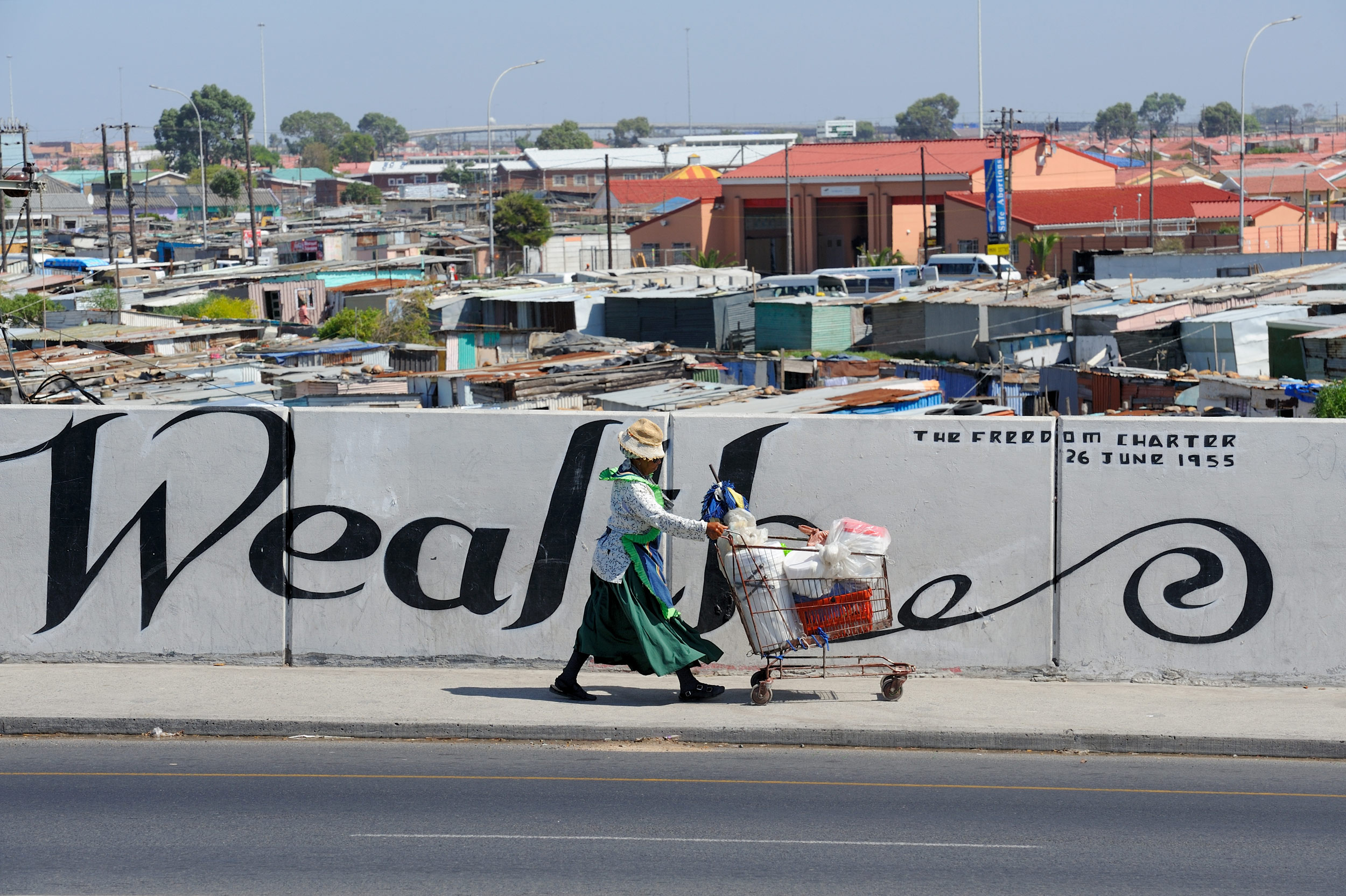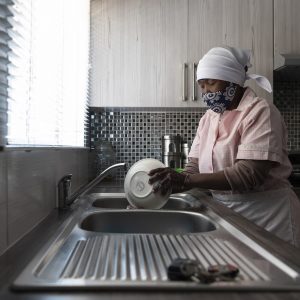Puffery and confusion mark SA’s recovery plan
A closer look at the numbers in the medium-term budget reveals recycled projects, a U-turn on previous commitments – and shattered hopes for mass economic upliftment.
Author:
9 November 2020

Seven months after the start of a once-in-a-century economic depression that could wipe out the limited gains of South Africa’s democracy, the government has presented a recovery plan that recycles old infrastructure projects from the years when Jacob Zuma was president. It also presented a medium-term budget policy statement (MTBPS) that doubled down on austerity and could herald the start of a second “lost decade” in terms of economic development.
Between 1994 and 2019, GDP per capita, an international benchmark of average living standards that divides the size of an economy by its population, grew by only 28%. By comparison, GDP per capita in China and India grew by 760% and 300%, respectively, over the same period. Between 2009 and 2019, South Africa had a “lost decade” during which GDP per capita did not grow. Over the past 10 years, according to the MTBPS, “real GDP growth averaged 1.4% while the population grew by 1.6% a year”.
There were five consecutive years of declining GDP per capita between 2015 and 2019. By the end of 2020, after an expected 10% decline in GDP per capita, South Africans will on average be only 15% richer than they were in 1994. According to optimistic forecasts in the National Treasury’s Budget Review, the economy “will only recover to 2019 levels in 2024”. Given that the treasury’s GDP growth forecasts have been wrong for most of the past decade in that they were too optimistic, it could take longer for the country to reach the GDP level of 2019.
The elusive Infrastructure Fund
In his speech to Parliament on 15 October in which he announced the latest economic recovery plan, President Cyril Ramaphosa said: “We are embarking on a massive rollout of infrastructure throughout the country. The Infrastructure Fund will provide R100 billion in catalytic finance over the next decade, leveraging as much as R1 trillion in new investment for strategic catalytic projects.”
However, on 21 September 2018, while presenting a previous “stimulus and recovery plan”, Ramaphosa said: “With a view to unlocking the potential to create more jobs on a large scale, we have decided to set up a South Africa Infrastructure Fund. The contribution from the fiscus towards the Infrastructure Fund over the medium-term expenditure framework period would be in excess of R400 billion, which we will use to leverage additional resources from developmental finance institutions, multilateral development banks, and private lenders and investors.”
The medium-term expenditure framework (MTEF) period is three years. But just five months after that speech, the treasury cancelled Ramaphosa’s commitment. Then, in its 2019 Budget Review, the treasury said: “Government intends to commit at least R100 billion to the fund over the coming decade to leverage private sector and development finance.” Yet the 2019 budget provisionally allocated R1 billion to the Infrastructure Fund in the 2019-2020 fiscal year, nothing in 2020-2021 and R4 billion in 2021-2022.
Related article:
The 2020 Budget Review said the fund’s implementation unit, which is situated in the Development Bank of Southern Africa, had a target to develop a pipeline of projects worth R700 billion over the next decade. On 5 October 2020, the bank finally appointed someone to head the fund.
In his recent speech to Parliament, Ramaphosa also announced a number of mega human settlements projects worth R44.5 billion. These were Matlosana in the North West, Lefhureng in Gauteng, Greater Cornubia in KwaZulu-Natal and Vista Park in the Free State. But the R8 billion Matlosana project to build 6 800 houses started in 2018, according to the developer, MXN Development Construction.
Lefhureng, to the west of Soweto, was originally announced in 2010 and the first phase was implemented in 2012-2013. The project website says the construction of 2 000 new houses has started. The R25 billion Greater Cornubia project to build 58 000 houses in Durban started in 2015. The contracts to build 5 300 houses at Vista Park in Bloemfontein were signed in 2014, according to the developer, Calgro M3. Houses are already for sale.
Where the problems lie
The 2020 MTBPS says the government has committed R18 billion over the MTEF to its “blended finance” Infrastructure Fund. However, the allocation has not yet appeared in the budget.
There are three problems with the government’s infrastructure plan. First, private investment responds with a time lag – or delay – to increased GDP growth. It does not kick-start the economy, no matter how much the president pleads with investors. Blended finance, which blends public and private funds, has been a failure internationally, with investors demanding huge subsidies to eliminate all risks from infrastructure projects. The Gautrain is an example.
In South Africa, where poverty levels are high and even middle-class people refuse to pay e-tolls, the financialisation of infrastructure to create a new asset class for investors is not viable.
Related article:
Second, a public sector investment strike has been the main reason for the decline of total investment between 2015 and 2019. Public investment by general government and state-owned companies (SOCs) has collapsed by 22% over this period. The government has not explained how it will reverse this trend and repair the broken balance sheets of SOCs.
Last, there can be no infrastructure-led recovery in the context of austerity budgets, which depress GDP growth and reduce infrastructure spending. As the MTBPS says, South Africa is “on course for its fourth consecutive year of contracting investment”, and the treasury has forecast a fifth year of declining investment during 2021. This shows that it does not believe the hype of an infrastructure-led recovery.
Contraction in real spend
South Africa has had three budgets since the start of 2020. On 26 February, the treasury announced budget cuts of R260 billion, which included reductions of R160.2 billion in the wage bill during the MTEF period until 2023. The budget projected public sector wage increases of 1.5% during the 2020-2021 fiscal year, 4.5% during 2021-2022 and 4.4% for 2022-2023. It also made increased allocations of R111 billion, which included R60.2 billion to Eskom and South African Airways. The net result was a R156 billion reduction in non-interest expenditure during the three-year period. The Budget Review said: “Over the next three years, consolidated non-interest expenditure will contract at an annual real average rate of 0.4%.”
On 24 June, the treasury announced a supplementary budget, which included financing details of the R500 billion stimulus package that Ramaphosa had announced on 21 April in response to the Covid-19 pandemic. The package had three components: the government’s response through the budget, a R200 billion loan guarantee scheme, and R40 billion that the Unemployment Insurance Fund (UIF) would pay to workers who were temporarily laid off. The treasury allocated R145 billion to the Covid-19 response, which was offset by budget cuts of R109 billion. Therefore, the increase in non-interest expenditure was only R36 billion or 0.7% of GDP. There would be a 1.8% real (after inflation) increase in non-interest expenditure during 2020-2021.
But there would be budget cuts of R233.5 billion over the next two years: R91.6bn in 2021-2022 and R141.9 billion in 2022-2023. The loan scheme has been a dismal failure with banks using a state guarantee to shift loans of only R16 billion towards prime clients. It should not be counted as part of the stimulus since there was no additionality – loans given to people who would not have received them. By the end of September, the UIF had paid R47.4 billion to 10.6 million beneficiaries from 931 000 employers. This means that the real stimulus – new money injected into the economy – so far has been about R83.4 billion or 1.6% of GDP. The treasury has effectively cancelled Ramaphosa’s R500 billion stimulus package.
Hard austerity
In the weeks before the MTBPS, there had been scathing criticism from mainstream economists of the treasury’s proposed “hard” austerity measures. Critics included the Presidential Economic Advisory Council, Philippe Burger, a professor of economics at the University of the Free State, and Mike Sachs, an adjunct professor at the University of the Witwatersrand who used to be treasury’s budget director. Burger wrote that the primary surplus – the difference between government’s non-interest spending and tax revenues – required to stabilise debt below 90% in 2023-2024 was politically and economically undesirable. It would be self-defeating as it would reduce GDP growth, the denominator or bottom part of the debt-to-GDP ratio.
There were hopes that the treasury would respond with “soft” austerity measures. While the MTBPS did not budge on some issues, it relented a little on others. Having declared war against public sector unions in February, the treasury fired the first shot in the battle when it announced a three-year wage freeze. It also limited the increase in non-interest spending to the previously budgeted R36 billion for 2020-2021, despite having to finance an extra R10.5 billion allocation to South African Airways. But the treasury had to accommodate additional spending pressures over the next two years, for example, the need to spend R100 billion on “mass employment” schemes in three years. During 2020-2021, the government will spend R12.6 billion to create “mass employment” for about 800 000 people at an average cost per employee of about R3 000 a month.
Related article:
It announced additional spending of R77.7 billion over the next two years – R28.7 billion in 2021-2022 and R49 billion in 2022-2023. As a result, the previously budgeted cuts of R233.5 billion for the next two years that were announced in the supplementary budget were reduced to R155.8 billion – R62.9 billion in 2021-2022 and R92.9 billion in 2022-2023.
There will be additional cuts of R150.9 billion in 2023-2024. Therefore, the previously proposed three-year fiscal consolidation path that would have resulted in the debt-to-GDP ratio peaking at 87.4% in 2023-2024 has been extended to five years. This will require an implausible swing from a primary deficit of 9.8% of GDP to a surplus by 2025-2026. The debt-to-GDP ratio will stabilise at 95.3% of GDP, the treasury says.
Less money for teachers, nurses and police
Over the next three years, there will be budget cuts of R306.7 billion, most of which will be achieved from the public sector wage freeze, according to the treasury. “Main budget non-interest expenditure is projected to contract in real (after inflation) terms in each year of the MTEF period. Real compensation expenditure will decline by an average of 3.5% a year over the medium term,” the MTBPS says. “More than 80% of the compensation reductions occur in learning and culture, health, and peace and security functions. These labour-intensive functions account for the majority of personnel in the public service.”
But the “savings” from the consolidated budget over the next two years are only R79.3 billion using the 2020 budget baseline. To achieve the final year’s cuts of R150.9 billion, there will have to be massive retrenchments or further cuts to spending on infrastructure and goods and services.
Related article:
South Africa is witnessing a slow-moving train smash. According to the treasury’s own forecasts, final government consumption spending, an important component of GDP, will decrease by 2.5% in 2021, 2.4% in 2022 and 3.6% in 2023.
In its optimistic forecasts for the next three years, the government is the only drag on GDP growth. The proposed budget cuts will result in a downward spiral of lower GDP growth and a higher debt ratio. The lower tax revenues and additional allocations to bankrupt SOCs, social security funds and municipalities will result in further cuts to the budgets for “mass employment” schemes, infrastructure spending and the retrenchment of doctors, nurses, teachers and police officers. The next decade until 2030 will be worse than the “lost decade” between 2009 and 2019.




